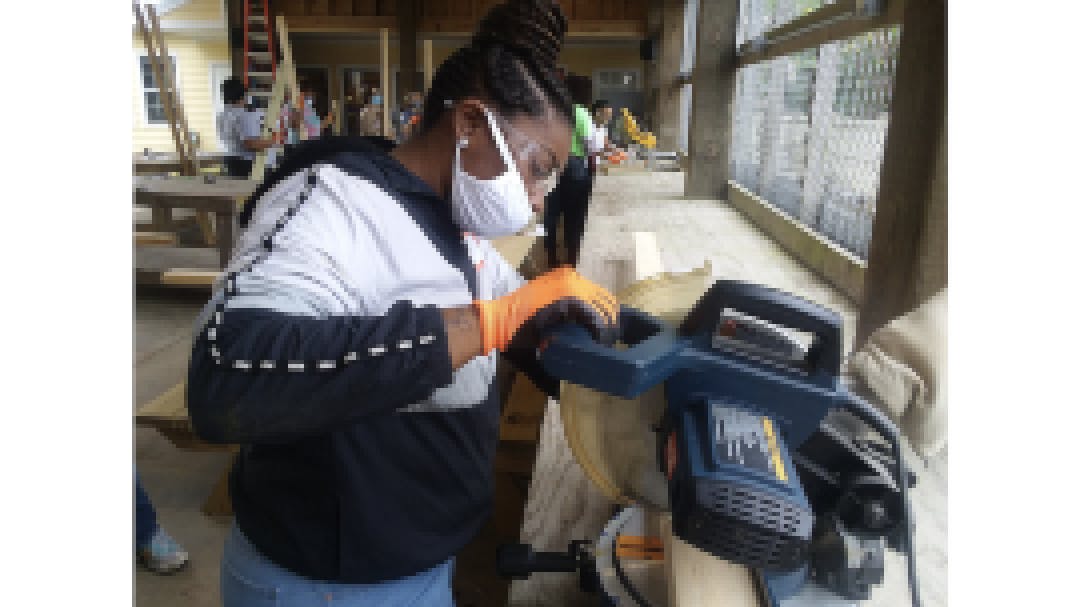
When Hurricane Katrina swept through the Gulf Coast in 2005, the storm decimated entire communities in Alabama, Louisiana and Mississippi. Demolishing the wreckage and rebuilding infrastructure required significant labor.
To a nonprofit based in East Biloxi, an area of Mississippi with high rates of poverty, that sounded like an opportunity to help women find work.
Moore Community House had supported working mothers and their children for decades, most recently through an Early Head Start program serving pregnant women, infants and toddlers. After the hurricane tore through, leaders of the organization wanted to make sure that women could take advantage of the jobs associated with the rebuilding effort.
Yet construction is an industry plagued by what experts call “occupational segregation.” Plainly put, that means women are very underrepresented in the profession. They account for only about 10 percent of construction workers, so they don’t have much access to entire categories of jobs that pay decent wages without requiring a college degree.
In Mississippi, that relegates many women who don’t have higher education to working part-time jobs for close to minimum wage—$7.25 an hour.
To start to change that, in 2008 Moore Community House created a new program called Women in Construction. It’s an eight-week training course designed to prepare women for apprenticeships and jobs in the skilled trades, which can set them up for careers that start out paying double or triple the minimum wage. The program uses a curriculum that offers participants nationally recognized credentials and teaches key skills like how to handle building materials and stay safe on a job site. Beyond that, it also helps women buy the tools and steel-toe boots they will need to bring to work, and it connects those who have children with resources to provide for their care.
“We know that for women, especially single moms, child care is a work-support in general,” says Ruth Mazara, program director of Women in Construction. “In order for a single mom to participate in any sort of job training that leads to a higher wage, that’s an imperative support service.”
Women in Construction is the kind of program that leaders in the federal government say can help more women succeed in registered apprenticeships—and then break into better-paying fields. That’s a priority these days for the U.S. Department of Labor, whose data show that women make up only 13 percent of registered apprentices, despite comprising nearly half of the country’s workers.
To start to shift those figures, the department makes Women in Apprenticeship and Nontraditional Occupations grants to organizations like Moore Community House (which received $750,000 from the government in 2021). Lately, interest in applying for WANTO support—and in recruiting and retaining more women in job-training programs—has been high, according to Sarah Glynn, a senior advisor in the Women’s Bureau at the Department of Labor.
“There is broad recognition that we are leaving a lot of talent on the table when we exclude women from certain occupations,” she says. “I think there is enormous appetite for this.”

Barriers to Entry
But even with increased community interest, specially-designed programs and federal dollars, barriers remain for women seeking access to jobs that predominantly employ men.
Occupational segregation by gender tends to keep women—and especially women of color—out of well-paying fields while clustering them in low-paying ones. According to federal research, of the 20 occupations with the highest weekly earnings in 2021, nine of them employ fewer than 25 percent women. These jobs include information security analyst and engineering roles of all types. Only one of these high-paying fields is women-dominated: nurse practitioner.
By contrast, of the 20 occupations with the lowest weekly earnings, eight are women-dominated, including restaurant host, housekeeper, child care worker, home health aide and hairdresser. Only one employs mostly men: vehicle cleaner.
As part of a nationwide push to elevate the value of work skills rather than credentials, policymakers, employers and educators have been encouraging students and job seekers to consider pursuing skilled trades like construction that don’t require bachelor’s degrees. Yet women lag behind in these industries for several reasons, according to Glynn.
One is that cultural norms and gender stereotypes have proven hard to shake, and are sometimes embedded into education systems that track children early on into traditional career paths. A second is structural systems that pose extra challenges for women, like the fact that protective gear that fits them tends to be harder to find.
A third is the reality that “there is a documented problem with discrimination and harrassment in some of these occupations as well and on some of these job sites,” Glynn says. It can be subtle, like assigning women less-desirable tasks, fewer shifts and fewer overtime opportunities to advance their skills. Or it can be overt physical and emotional abuse.
In Biloxi, even if the leaders of companies and skilled trades organizations are eager to diversify their teams, women sometimes arrive and discover workplace cultures that aren’t so welcoming, Mazara says. If a supervisor isn’t treating women well or other discrimination is taking place, Moore Community House steps in to advocate on behalf of alumnae with their new employers.
“We’ll let them know, ‘Do you know this is going on?’” Mazara says. “‘I can’t send workers to you if this happens.’”

Child Care Required
Finding affordable child care is another major factor affecting the extent to which women can pursue apprenticeships and other job-training programs, experts say.
That’s especially true for single mothers. And in the county where Moore Community House is located, more than 42 percent of households with children were headed by a single parent in 2020, according to data from the Federal Reserve Bank of St. Louis.
There are some circumstances unique to construction jobs that add an extra challenge, like the fact that such roles often require workers to show up very early in the morning.
“It doesn’t happen 9 to 5, and finding child care that will allow you to drop your kids off so you can be on a job site at 6 a.m. can be difficult,” Glynn says.
Yet even finding reliable care during more typical daytime hours can be a struggle. That’s why child care support is a big benefit of the Women in Construction program. Some participants are already enrolled in Moore Community House Early Head Start, which provides education, food and social services to families with young kids. Others receive six months of free child care at a provider of their choice, thanks to funds from the Mississippi Department of Human Services, philanthropic foundations and the federal WANTO grant.
“The intention is that they have the ability to fully focus on their coursework while they’re in the class—and then the job hunt itself is a full-time endeavor,” Mazara says.
Once women in Biloxi do land jobs in the skilled trades, the pay they earn typically enables them to better provide for their families. They can upgrade their transportation so it’s more reliable, and they can improve their housing situations—maybe even by buying a home.
“Once they get into it, they’re like, ‘I can breathe,’” Mazara says.
However, she adds, “a single mom of maybe two earning these wages is fantastic, but child care is still a needed work-support.” So Moore Community House encourages the more than 700 women it has trained in construction to apply for state aid for child care that helps them keep those costs down.
It’s an example of the advice that gets shared in communities of people who have similar life experiences and needs—which can turn into the type of supportive professional network that research shows can help women break into new fields.
“We tell our graduates,” Mazara says, “‘this isn’t the end—this is the beginning of our relationship.”

